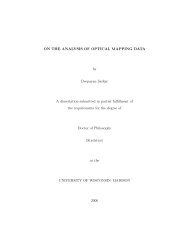Struggles with Survey Weighting and Regression Modeling paper
Struggles with Survey Weighting and Regression Modeling paper
Struggles with Survey Weighting and Regression Modeling paper
Create successful ePaper yourself
Turn your PDF publications into a flip-book with our unique Google optimized e-Paper software.
SURVEY WEIGHTING AND REGRESSION MODELING 157<br />
TABLE 3<br />
True<br />
Different st<strong>and</strong>ard error estimates<br />
st<strong>and</strong>ard assuming conditioning assuming design-<br />
Opinion of NYC error SRS on weights inv-prob based<br />
Became a better place 2.2% 1.2% 2.5% 1.9% 2.1%<br />
Remained the same 2.0% 1.2% 2.3% 1.6% 1.9%<br />
Gotten worse 2.0% 1.2% 2.4% 1.7% 2.0%<br />
From a simulation study: true st<strong>and</strong>ard error <strong>and</strong> four different st<strong>and</strong>ard error estimates for a question on the<br />
Social Indicators <strong>Survey</strong>. Ignoring the weighting or treating the weights as constant underestimates uncertainty,<br />
whereas uncertainty is overestimated by treating the weights as inverse probabilities. Accurate st<strong>and</strong>ard errors<br />
can be obtained using a jackknife-like procedure that explicitly takes account of the design of the weighting<br />
procedure. From Lu <strong>and</strong> Gelman (2003).<br />
by DuMouchel <strong>and</strong> Duncan, 1983; Kish,1992; Pfeffermann,<br />
1993). For the goal of estimating a population<br />
mean, it is st<strong>and</strong>ard to use the weighted average (3), but<br />
it is not so clear what to do in more complicated analyses.<br />
For example, when estimating a regression of y on<br />
z, one recommended approach is to use weighted least<br />
squares, <strong>and</strong> another option is to perform unweighted<br />
regression of y on z, also controlling for the variables<br />
X that are used in the weighting.<br />
Computing st<strong>and</strong>ard errors is not trivial for weighted<br />
estimates, whether means or regressions, because the<br />
weights themselves generally are r<strong>and</strong>om variables that<br />
depend on the data (Yung <strong>and</strong> Rao, 1996). In particular,<br />
correct classical st<strong>and</strong>ard errors cannot simply be<br />
obtained from the data <strong>and</strong> the weights; one also needs<br />
to know the procedure used to create the weights. Table<br />
3 illustrates problems <strong>with</strong> some variance estimates<br />
that do not account for the weighting design. Similarly,<br />
<strong>with</strong> regressions, simple weighted regression procedures<br />
do not in general give correct st<strong>and</strong>ard errors.<br />
1.4 The Crucial Role of Interactions<br />
Consider a regression of y on z, estimated in some<br />
way from a survey where inclusion probabilities depend<br />
on X. In general, y can depend on both X <strong>and</strong><br />
z, in which case the appropriate way to estimate the<br />
regression of y on z is to regress y on X, z <strong>and</strong>thenaverage<br />
over the population distribution of X. In general,<br />
estimating the regression of y on z requires estimation<br />
of the relation between z <strong>and</strong> X as well (Graubard <strong>and</strong><br />
Korn, 2002). Because of the potential dependence of z<br />
<strong>and</strong> X, it can be important to include interactions between<br />
these predictors in the model for y, evenifthe<br />
ultimate goal is simply to estimate the relation between<br />
y <strong>and</strong> z.<br />
In our survey adjustment framework, once a model<br />
includes interactions, poststratification is necessary in<br />
order to estimate population regression coefficients.<br />
For a simple example, suppose we are interested in<br />
the population regression of log earnings on height (in<br />
inches), using a survey that is adjusted to match the<br />
proportion of men <strong>and</strong> women in the population. The<br />
estimated regression (see Gelman <strong>and</strong> Hill, 2007) including<br />
the interaction is<br />
y = log(earnings)<br />
= 8.4 + 0.017 · height − 0.079 · male<br />
+ 0.007 · height · male + error.<br />
For any given height z, the expected value of log earnings<br />
is<br />
(4)<br />
E(y|z) = 8.4 + 0.017z<br />
− 0.079 · E(male|height = z)<br />
+ 0.007z · E(male|height = z).<br />
Here, E(male|height = z) would be estimated from<br />
the survey itself; most likely we would do this by fitting<br />
a linear regression (<strong>with</strong> Gaussian errors) of height<br />
given sex, <strong>and</strong> then simply using Bayes’ rule, along<br />
<strong>with</strong> the population proportions of men <strong>and</strong> women,<br />
to compute the conditional probability.<br />
The conditional expectation (4) is not, in general,<br />
a linear function of z. Thus, although we can define<br />
the population regression of log earnings on height—it<br />
is the result of fitting a simple linear regression of y on<br />
z to the entire population—it is not clear why it should<br />
be of any interest.<br />
This difficulty in interpreting regression coefficients<br />
in the context of survey adjustments is one reason we<br />
have been careful in Section 1.1 to consider estim<strong>and</strong>s<br />
that are simple comparisons of population averages.<br />
We illustrate <strong>with</strong> the goal of estimating the average
















